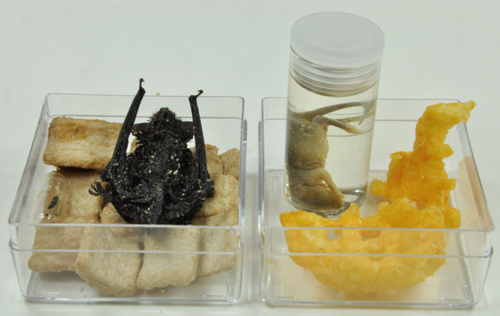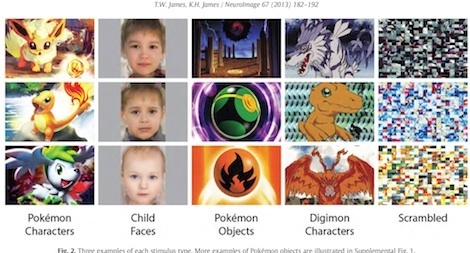Marc Abrahams's Blog, page 523
January 9, 2013
Hoping to Understand Heads and Tails, Indicatively
Heads and tails are two sides of the many-sided coin that is emotion. This study explores several sides, including those two:
“Indicators of positive and negative emotions and emotional contagion in pigs,” Inonge Reimert, J. Elizabeth Bolhuis, Bas Kemp, T. Bas Rodenburg, Physiology and Behavior, vol. 109, no. 17 January 2013, pp. 42–50. The authors, at Wageningen University, explain (among several explanations):
“Recently, ear and tail postures have been postulated as useful indicators of positive and negative emotions [30], [31], [32], [33] and [34]. In pigs only little research has been performed on tail postures (e.g., Ref. [35]), and, as far as we know, not on ear postures. We, therefore, investigated whether ear and tail postures could be indicators of positive and negative emotions in pigs.”
(Thanks to investigator Neil Martin for bringing this to our attention.)

January 8, 2013
The Human Tube Map
 Food & Function (a publication of the Royal Society of Chemistry) is a monthly peer-reviewed journal which provides a unique venue to publish work at the interface of the chemistry, physics and biology of food. For an example article see: Fluid mechanics of eating, swallowing and digestion – overview and perspectives, Jan Engmann and Adam S. Burbidge, Food & Function 2013, (advance article).
Food & Function (a publication of the Royal Society of Chemistry) is a monthly peer-reviewed journal which provides a unique venue to publish work at the interface of the chemistry, physics and biology of food. For an example article see: Fluid mechanics of eating, swallowing and digestion – overview and perspectives, Jan Engmann and Adam S. Burbidge, Food & Function 2013, (advance article).
“From a very simplistic viewpoint, the human digestive system can be regarded as a long tube (with dramatic variations in diameter, cross-section, wall properties, pumping mechanisms, regulating valves and in-line sensors).”
The unique image used to complement the paper is part of an artwork entitled ‘Underskin’ by Sam Loman M.A. The illustration, heavily inspired by the London Underground system map (colloquially know as the Tube Map) equates the digestive system with the Circle Line (shown in yellow). Appropriately enough, for like the Circle Line, the digestive system is not circular. The artwork is available as a poster, fine art print, postcards etc

January 7, 2013
How to test a little finger
You may have your own methods for testing a little finger. This video shows how it’s done in Rotterdam:

Childish: 2nd-hand looks at brain activity
Some brain scientists use their brains to explain how they think other people’s brains are used. They also use (in addition to their brains) fMRI [functional magnetic resonance imaging], a technique in which complex equipment measures some of the things that happen inside a brain while a person is using that brain. (NOTE: the technique has also proved illuminating when used on dead salmon or other biological entities.) Two new studies center on childish thinking:
“Neural Activity during Natural Viewing of Sesame Street Statistically Predicts Test Scores in Early Childhood,” Jessica F. Cantlon and Rosa Li, PLoS Biol, 11(1), January 3, e1001463. (Thanks to investigator Laura Emmons for bringing this to our attention.) The authors, at the University of Rochester, New York, explain:
“This more ecologically natural paradigm, combined with the novel measure of ‘neural maturity,’ provides a new method for studying real-world mathematics development in the brain.”
and
“Expert individuation of objects increases activation in the fusiform face area of children,” Thomas W. James and Karin Harman James, NeuroImage, vol. 67, February 15 2013, pp. 182–192. (Thanks to investigator Neil Martin for bringing this to our attention.) The authors, at Indiana University, explain:
“Here, two groups of school-aged children — one group with an EII with Pokémon cards and another group of age-matched controls — underwent fMRI while viewing faces, Pokémon characters, Pokémon objects, and Digimon characters.”
Here, below, is some detail from that second study:

January 6, 2013
The iPod — a shield, weapon, or both?
 Whether you see the iPod as a defence mechanism or a means of exhibiting aggression may depend on your point of view. Two recent academic studies address these possibly conflicting, and yet perhaps complementary viewpoints.
Whether you see the iPod as a defence mechanism or a means of exhibiting aggression may depend on your point of view. Two recent academic studies address these possibly conflicting, and yet perhaps complementary viewpoints.
The first paper, ‘The Portable Music Player as a Defense Mechanism’ was published in the Journal of Radio & Audio Media in 2010, and describes how experiments were conducted to determine if an iPod might somehow be used to ‘defend’ against certain kinds of intruders.
“Respondents were asked how they would react, in terms of their iPods and earbuds, if approached by someone that interested them, somewhat interested them or did not interest them. Results suggested that respondents reacted differently the less the approaching person interested them, signifying a defensive mechanism somewhat akin to that employed by cellular phone users.”
As a contrast, a more recent paper examines instead the iPod’s contribution to ‘passive mp3 listening’ – and in particular “ … the unique elements of passive listening which make it different from many other acts of musical violence …”
See: ‘Assaulted by the iPod: The Link between Passive Listening and Violence.’ Popular Music and Society, Volume 34, Issue 1, 2011
“In response to the rise in the number of MP3 players in use, and anecdotal evidence of their annoyance value, this paper examines the link between passive MP3 player listening and violence. In examining the link, it first presents the concept of a “passive listener,” then looks at the issue of control and choice, and the different levels to which these are present in controlled and passive listening. It then examines the unique elements of passive listening which make it different from many other acts of musical violence, before summarizing the effect on the passive listener. Finally, the paper suggests strategies to minimize the effects of passive listening as a form of violence, before suggesting areas for further research.”
QUESTION:
Aside from attack /defence, what alternative uses may be found for an i-Pod ? For inspiration, see : “Stick It In Your Ear: The Psychodynamics of iPod Enjoyment,” Communication and Critical/Cultural Studies 5 (2008): 135-157. Joshua Gunn and Mirko M. Hall,

Psychopathic Personality Traits in Couples
Make what you will of this:
“Correlates of psychopathic personality traits in community couples,” Claudia Savard, Stéphane Sabourin and Yvan Lussier, Personality and Mental Health, epub March 24, 2011. The authors, at Université Laval, Québec, Canada, and Université du Québec à Trois-Rivières, Trois-Rivières, Québec, Canada, explain:
“there was a direct negative path from secondary psychopathy to couple satisfaction, but this association was partially mediated by personal distress and psychological aggression.”

The distance between musical notes
Today’s quick calculation exercise is to calculate the relative distances between different musical notes and a trombone player’s face. Watch this video of a trombone player playing a tune on a trombone. A GoPro camera has been affixed to part of the trombone, and aimed at the musician’s face:
(Thanks to investigator Dorothy Bond for bringing this to our attention.)

January 5, 2013
“How to swim with sharks: A Primer”
In honor or shark-swimming season (see below for implied date limits and locations), here’s the beginning of an essay by Richard J. Johns [pictured here], attributed by him to Voltaire Cousteau:
How to Swim With Sharks: A Primer
Forward
Actually, nobody wants to swim with sharks. It is not an acknowledged sport and it is neither enjoyable nor exhilarating. These instructions are written primarily for the benefit of those, who, by virtue of their occupation, find they must swim and find that the water is infested with sharks.
It is of obvious importance to learn that the waters are shark infested before commencing to swim. It is safe to say that this initial determination has already been made. If the waters were infested, the naïve swimmer is by now probably beyond help; at the very least, he has doubtless lost any interest in learning how to swim with sharks.
Finally, swimming with sharks is like any other skill: It cannot be learned from books alone; the novice must practice in order to develop the skill. The following rules simply set forth the fundamental principles which, if followed will make it possible to survive while becoming expert through practice.
Rules
Assume all unidentified fish are sharks. Not all sharks look like sharks, and some fish that are not sharks sometimes act like sharks. Unless you have witnessed docile behavior in the presence of shed blood on more than one occasion, it is best to assume an unknown species is a shark. Inexperienced swimmers have been badly mangled by assuming that docile behavior in the absence of blood indicates that the fish is not a shark.
Do not bleed. It is a cardinal principle that if you are injured, either by accident or by intent, you must not bleed. Experience shows that bleeding prompts an even more aggressive attack and will often provoke the participation of sharks that are uninvolved or, as noted above, are usually docile.
Admittedly, it is difficult not to bleed when injured. Indeed, at first this may seem impossible. Diligent practice, however, will permit the experienced swimmer to sustain a serious laceration without bleeding and without even exhibiting any loss of composure. This hemostatic reflect can, in part, be conditioned, but there may be constitutional aspects as well. Those who cannot learn to control their bleeding should not attempt to swim with sharks, for the peril is too great.The control of bleeding has a positive protective element for the swimmer. The shark will be confused as to whether or not his attack has injured you and confusion is to the swimmer’s advantage. On the other hand, the shark may know he has injured you and be puzzled as to why you do not bleed or show distress. This also has a profound effect on sharks. They begin to question their own potency or, alternatively, believe the swimmer to have supernatural powers.
Counter any aggression promptly. Sharks rarely attack a swimmer without warning. Usually there is some tentative, exploratory aggressive action. It is important that the swimmer recognize that this behavior is a prelude to an attack and takes prompt and vigorous remedial action….
The essay was published in Perspectives in Biology and Medicine 1981; 30: 486-489. [Some records indicate the year was 1987]

The breakfast-cereal bat comes to roost at the museum
The pipistrelle bat (Pipistrellus pipistrellus) that made headlines (and this blog) in Germany last November, after the Chemisches und Veterinäruntersuchungsambt (CVUA-Stuttgart) reported its find in a box of breakfast cereals, is in the news again. The mummified insectivore is now a registered specimen (NMR 9990- 03109) in the Natural History Museum of Rotterdam, the Netherlands.
The museum’s curator, Kees Moeliker, requested the bat from the German authorities, hoping to put it on display next to the museum’s other dead-animals-that-tell-a-story or are famous otherwise. To the curator’s joy, the bat – now know as the Breakfast Bat or ‘Früstücksvleermuis’ in German/Dutch lingo – was donated to the museum together with his last excrements and a nice sample of the original breakfast cereals.
The ensemble is now on display in the museum, next to the newborn mouse that was found in a bag of crisps and the first-ever preserved peanut butter trapped mouse from the Dutch Parliament Building.
The Breakfast Bat is the first foreign addition to the famous-dead-animal collection of the Rotterdam museum. It all started with the necro-duck (1995) and the Domino Sparrow (2005).

January 4, 2013
Teller tells about deception, perhaps truthfully
 Teller, the usually-one-named magician who partners with the often-two-named Penn Jillette to form the pair called Penn & Teller, talks about deception, in an essay in Smithsonian magazine. He begins to get to the point, by saying:
Teller, the usually-one-named magician who partners with the often-two-named Penn Jillette to form the pair called Penn & Teller, talks about deception, in an essay in Smithsonian magazine. He begins to get to the point, by saying:
Magic’s not easy to pick apart with machines, because it’s not really about the mechanics of your senses. Magic’s about understanding—and then manipulating—how viewers digest the sensory information.
I think you’ll see what I mean if I teach you a few principles magicians employ when they want to alter your perceptions….
Teller says that, sometimes, he and Penn work to make their audience laugh… and then NOT think:
3. It’s hard to think critically if you’re laughing. We often follow a secret move immediately with a joke. A viewer has only so much attention to give, and if he’s laughing, his mind is too busy with the joke to backtrack rationally.
BONUS:

Marc Abrahams's Blog
- Marc Abrahams's profile
- 14 followers




